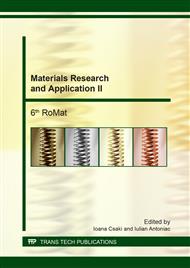[1]
C. Piconi, A.A. Porporati, Bioinert Ceramics: Zirconia and Alumina, Handbook of Bioceramics and Biocomposites, Springer International Publishing Switzerland 2015, pp.1-25.
DOI: 10.1007/978-3-319-09230-0_4-1
Google Scholar
[2]
J. Fisher, B. Stawarczyk, Compatibility of machined Ce-TZP/Al2O3 nanocomposite and a veneering ceramic. Dent. Mater. 2 (2007) 1500-1505.
DOI: 10.1016/j.dental.2007.01.005
Google Scholar
[3]
M. Cattani-Lorente, S.S. Scherrer, P. Ammann, M. Jobin, A. Wiskott, Low temperature degradation of a YTZP dental ceramic. Acta Biomater. 7 (2011) 858-865.
DOI: 10.1016/j.actbio.2010.09.020
Google Scholar
[4]
H. El Attaoui, M. Saâdaoui, J. Chevalier, G. Fantozzi, Static and cyclic crack propagation in Ce-TZP ceramics with different amounts of transformation toughening, J. Eur. Ceram. Soc. 27 (2007) 483-486.
DOI: 10.1016/j.jeurceramsoc.2006.04.108
Google Scholar
[5]
M. Nawa, S. Nakamoto, T. Sekino, K. Niihara, Tough and strong Ce-TZP/Alumina nanocomposites doped with Titania, Ceram. Int. 24 (1998) 497-506.
DOI: 10.1016/s0272-8842(97)00048-5
Google Scholar
[6]
R.A. Cutler, J.M. Lindemann, J.H. Ulvensøen, H.I. Lange, Damage-resistant SrO-doped Ce-TZP/Al2O3 composites, Mater. Design 15 (1994) 123-133.
DOI: 10.1016/0261-3069(94)90111-2
Google Scholar
[7]
R.A. Cutler, R.J. Mayhew, K.M. Prettyman, A.V. Virkar, High-Toughness Ce-TZP/Al2O3 Ceramics with improved hardness and strength, J. Am. Ceram. Soc. 74 (1991) 179-186.
DOI: 10.1111/j.1151-2916.1991.tb07315.x
Google Scholar
[8]
P. Palmero, V. Naglieri, J. Chevalier, G. Fantozzi, L. Montanaro, Alumina-based nanocomposites obtained by doping with inorganic salt solutions: Application to immiscible and reactive systems, J. Eur. Ceram. Soc. 29 (2009) 59-66.
DOI: 10.1016/j.jeurceramsoc.2008.05.047
Google Scholar
[9]
P. Palmero, M. Fornabaio, L. Montanaro, H. Reveron, C. Esnouf, J. Chevalier, Towards long lasting zirconia-based composites for dental implants. Part I: Innovative synthesis, microstructural characterization and in vitro stability, Biomaterials 50 (2015).
DOI: 10.1016/j.biomaterials.2015.01.018
Google Scholar
[10]
H. Reveron, M. Fornabaio, P. Palmero, T. Fürderer, E. Adolfsson, V. Lughi, A. Bonifacio, V. Sergo, L. Montanaro, J. Chevalier, Towards long lasting zirconia-based composites for dental implants: Transformation induced plasticity and its consequence on ceramic reliability, Acta Biomater. 48 (2017).
DOI: 10.1016/j.actbio.2016.11.040
Google Scholar
[11]
A. Douy, M. Capron, Crystallisation of spray-dried amorphous precursors in the SrO–Al2O3 system: a DSC study, J. Eur. Ceram. Soc., 23 (2003) 2075-(2081).
DOI: 10.1016/s0955-2219(03)00015-3
Google Scholar
[12]
M. Fornabaio, P. Palmero, R. Traverso, C. Esnouf, H. Reveron, J. Chevalier, L. Montanaro, Zirconia-based composites for biomedical applications: Role of second phases on composition, microstructure and zirconia transformability. J. Eur. Ceram. Soc. 35 (2015).
DOI: 10.1016/j.jeurceramsoc.2015.04.027
Google Scholar
[13]
J. Fischer, B. Stawarczyk, Compatibility of machined Ce-TZP/Al2O3 nanocomposite and a veneering ceramic. Dental. Mater., 23 (2007) 1500-1505.
DOI: 10.1016/j.dental.2007.01.005
Google Scholar
[14]
S. Ban, H. Sato, Y. Suehiro, H. Nakanishi, M. Nawa, Biaxial flexural strength and low temperature degradation of Ce-TZP/Al2O3 nanocomposite and Y-TZP as dental restoratives. J Biomed. Mater. Res. Part B: Appl. Biomater., 87B (2008) 492-498.
DOI: 10.1002/jbm.b.31131
Google Scholar
[15]
H. El Attaoui, M. Saâdaoui, J. Chevalier, G. Fantozzi, Static and cyclic crack propagation in Ce-TZP ceramics with different amounts of transformation toughening, J. Eur. Ceram. Soc., 27 (2007) 483-486.
DOI: 10.1016/j.jeurceramsoc.2006.04.108
Google Scholar
[16]
P.F. Becher, C.H. Hsueh, P. Angelini, T.N. Tiegs, Toughening behavior in whisker-reinforced ceramic matrix composites, J. Am. Ceram. Soc., 71 (1988) 1050-1061.
DOI: 10.1111/j.1151-2916.1988.tb05791.x
Google Scholar
[17]
F. Kern, A comparison of microstructure and mechanical properties of 12Ce-TZP reinforced with alumina and in situ formed strontium-or lanthanum hexaaluminate precipitates, J. Eur. Ceram. Soc., 34 (2014) 413-423.
DOI: 10.1016/j.jeurceramsoc.2013.08.037
Google Scholar
[18]
J. Chevalier, L. Gremillard, S. Deville, Low-temperature degradation of zirconia and implications for biomedical implants, Ann. Rev. Mat. Res., 37 (2007) 1-32.
DOI: 10.1146/annurev.matsci.37.052506.084250
Google Scholar


